Introduction
In today's rapidly changing blockchain technology, Bitcoin is not only widely accepted as a digital asset, but its underlying technology is also constantly evolving and innovating. As the Bitcoin ecosystem gradually expands, various Layer2 solutions are emerging like mushrooms after the rain, aiming to improve the scalability, efficiency, and security of the Bitcoin network. This article will delve into several innovative Bitcoin Layer2 projects. Through a detailed analysis of the technical principles, team background, financing situation, and development roadmap of these projects, we will understand how they are driving the innovation and development of the Bitcoin ecosystem.
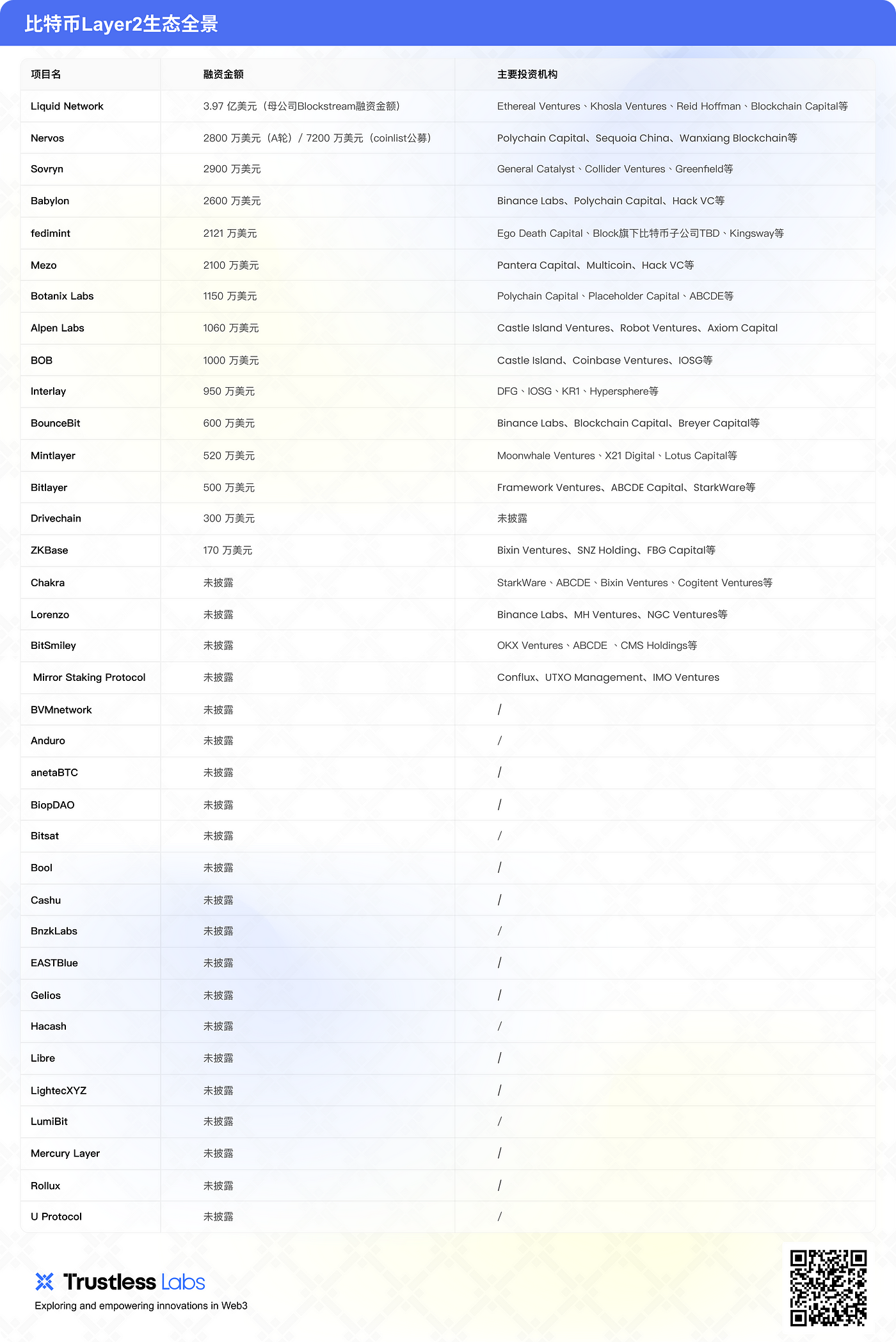
Babylon: Cross-chain staking and Bitcoin economic security
Babylon uses cryptographic methods to utilize the native staking of Bitcoin (BTC) to provide security for proof-of-stake (PoS) for other blockchains. This mechanism not only brings on-chain income to BTC but also has attracted widespread market attention.
In terms of technical implementation, Babylon's staking process relies entirely on cryptography, without the need for third-party bridges or custodians. BTC stakers can stake by sending transactions with two UTXO outputs. The first UTXO writes a time-locked script, and after expiration, the staker can unlock BTC with a private key. The second UTXO is transferred to a temporary Bitcoin address, and the public-private key pair of this address complies with the cryptographic standard "extractable one-time signature (EOTS)." When the staker runs a node of the PoS chain and verifies a uniquely valid block, they sign it with the EOTS private key.
If the staker operates honestly and signs only one valid block at a time, they will receive rewards as validators of the PoS chain. If they attempt to act maliciously and sign two blocks at the same time, their EOTS private key will be reverse-engineered, allowing anyone to transfer the staked BTC using that private key, resulting in confiscation and prompting the staker to remain honest. Babylon also provides BTC timestamp services by uploading checkpoint data of any blockchain to BTC's op_return, enhancing security.
Babylon's staking is cross-chain staking, and the staked BTC is kept in scripts on the Bitcoin network. Stakers can specify validators to earn rewards on the corresponding PoS chain. By staking BTC to provide economic security for other PoS chains, BTC can earn income without leaving the main network, opening up a new way to stake BTC and greatly changing the BTC ecosystem.
According to DefiLlama's data, the current BTC yield market size exceeds $10 billion, with active income of $4 billion and yields ranging from 0.01% to 1.25%. This generally requires entrusting third-party CeFi institutions, or bridging or wrapping BTC. Staking rewards on PoS blockchains usually range from 5% to 20%. Through Babylon's staking business, BTC does not need to be entrusted to third-party institutions and can earn 50 times more than traditional BTC income, with tremendous growth potential.
However, the majority of BTC holders are passive holders, with 25% of BTC unused for over 5 years, and 67% of BTC held for over 1 year. Therefore, convincing BTC holders to participate in staking is somewhat challenging. Babylon is conducting testnet staking and plans to launch the mainnet test in May-June, with no announcement yet of the launch of staking BTC voucher-like assets.
Babylon was founded by Stanford University professors David Tse and Dr. Fisher Yu in 2022. Professor Yu is a member of the US National Academy of Engineering and is known for his legendary proportional fair scheduling algorithm in the field of wireless communication. On December 7, 2023, Babylon completed a $18 million financing round, led by Polychain Capital and Hack VC, with participation from Framework Ventures, Polygon Ventures, OKX Ventures, IOSG Ventures, among others. On February 24, 2024, Binance Labs announced its investment in Babylon.
Chakra: ZK-driven Bitcoin re-staking protocol
Chakra is a ZK-driven Bitcoin re-staking protocol designed to establish a secure Bitcoin PoS system. By utilizing ZK-STARKs and a middleware chain, the Chakra network has established a native modular paradigm for expanding the BTC ecosystem. On April 30, Chakra announced the completion of a new strategic financing round, with participation from StarkWare, Bixin Ventures, Cogitent Ventures, among others. Specific amounts and valuation information have not been disclosed.
Chakra aims to address liquidity and interoperability challenges, unlocking the immense value of Bitcoin. With Chakra, other BTC Layer2 solutions can focus on the execution layer without overly focusing on the settlement of Bitcoin infrastructure.
The Chakra network unlocks liquidity and provides economic security through a shared settlement layer, empowering participants in the BTC ecosystem. Projects and DApps on the BTC Layer2 will benefit from the robust liquidity network effect in this secure, vibrant, and prosperous ecosystem.
Chakra allows Bitcoin holders to stake without transferring assets out of their wallets by generating UTXOs with time locks. Chakra uses STARK to implement the proof system. Compared to SNARK, STARK provides a zero-knowledge proof solution that does not require a trusted setup. Chakra uses STARKs technology to implement zk light clients, allowing verification of staking information without connecting to the Bitcoin network, ensuring the efficiency and security of zero-knowledge proofs. By introducing CairoVM, Chakra further enhances the system's scalability and transparency.
nubit_org: Protocol for extending Bitcoin data availability
Nubit is a protocol for extending data availability (DA) scenarios for BTC. It organizes a DA chain through PoS consensus and regularly uploads Nubit's DA data to the BTC main chain. Nubit does not have smart contract capabilities and requires Rollup to build on its DA. Users upload data to Nubit, which is confirmed by PoS consensus to enter a "soft confirmation" state. Subsequently, Nubit uploads the data root to the BTC main chain for final confirmation. Users need to upload data tags on the BTC main chain for querying original data in the Merkle tree of Nubit full nodes.
Currently, there are 100 BTC L2 solutions in the market. Even if all choose to upload DA to BTC blocks, the main network can support at most around 20 L2 solutions, filling the BTC blocks. Therefore, there is a significant narrative gap in how to connect with BTC and use its security guarantees. Nubit's DA repackaging approach is an interesting solution.
Nubit has completed the first round of Pre-Alpha Testnet, where users can earn points by linking their BTC accounts or running light nodes. The first round of the testnet has ended, and plans are underway for the second phase of the testnet. Angel round investors for Nubit include Bounce Finance and Brc20 founder Domo. They completed a $3 million Pre-Seed round of financing, with participation from dao5, OKX Ventures, Primitive Ventures, among others.
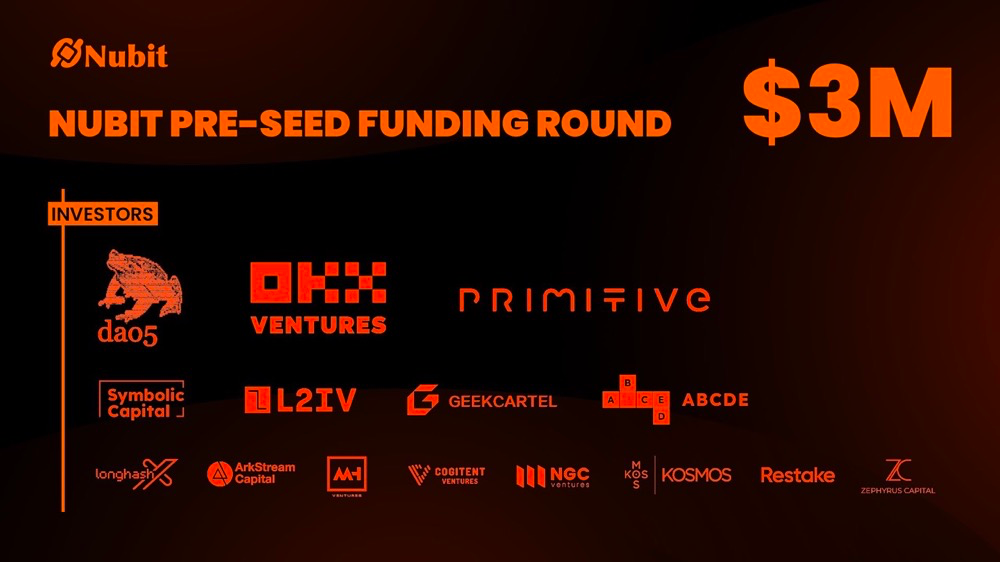
Lorenzo: Liquidity staking protocol for BTC
Lorenzo, built on Babylon, is a liquidity staking protocol that provides fast deployment services for L2-as-a-service, aiming to reduce the risk of penalties for stakers and release the liquidity of staked BTC assets. Stakers deposit BTC into Lorenzo's multi-signature address and receive an equivalent amount of stBTC as liquidity proof on its chain, as well as staking rewards.
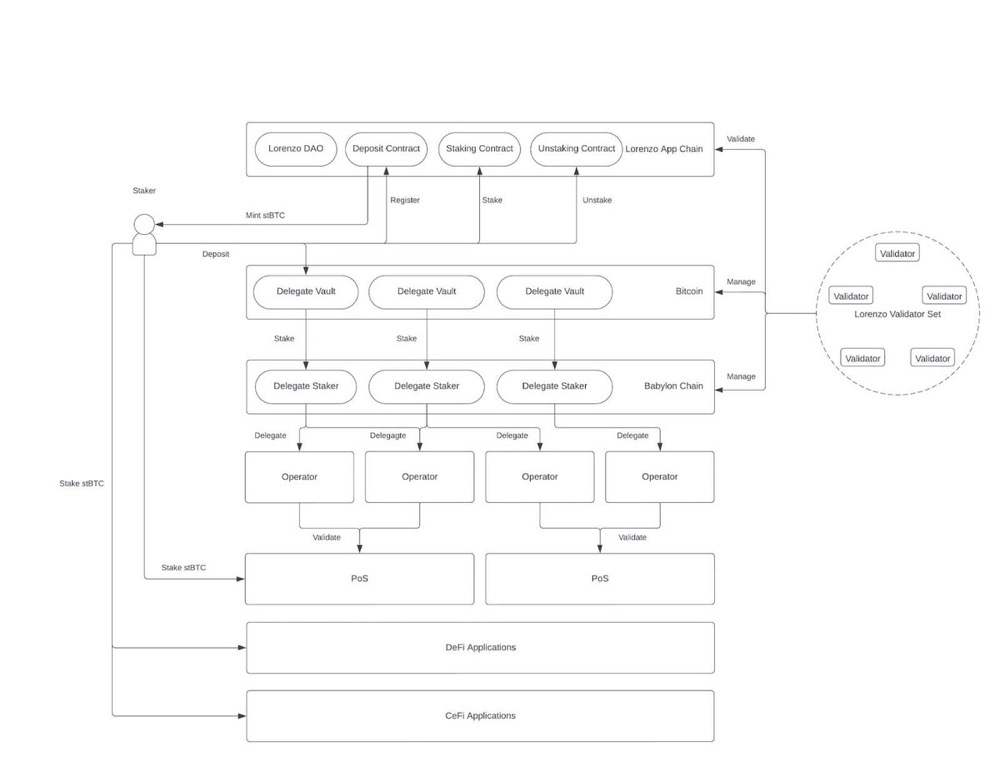
The Lorenzo chain itself is protected by Babylon's Bitcoin shared security and is an EVM-compatible Bitcoin L2, which will help deploy more BTC L2 in a modular way in the future. The Lorenzo chain serves as an interoperable chain for these L2 chains. Currently, Lorenzo has announced collaborations with Babylon, BounceBit, and plans to launch a testnet based on the Cosmos architecture. It is currently collaborating with the fourth phase of Babylon's testnet for liquidity re-staking testing.
According to Rootdata, Lorenzo has received investments from Binance, MH Ventures, and NGC Ventures, with specific details not disclosed. Currently, Lorenzo has announced the launch of pre-staking activities for Babylon and the joint hosting of the Bitlayer Mining Gala, where users can stake BTC to receive stBTC on the pre-staking Babylon activity page. All BTC received by Lorenzo will be staked by Lorenzo on Babylon as soon as it goes live. However, the actual staking progress may be subject to the staking limit of Babylon.
bitsmiley_labs: Comprehensive DeFi protocol for the Bitcoin ecosystem
BitSmiley is a comprehensive DeFi protocol for the Bitcoin ecosystem, including over-collateralized stablecoin issuance, decentralized lending, and derivatives. bitUSD is an over-collateralized stablecoin issued based on BitSmiley, similar to the MakerDAO mechanism, with a decentralized lending implementation similar to Compound. bitUSD can be implemented on both BTC's L1 and L2, issued based on the bitRC-20 standard, supporting functions such as upgrades, minting, and burning, making it easy to represent stablecoins on the BTC mainnet. BitSmiley has also developed the AMM bitCow for stablecoins, which is being deployed and tested on multiple BTC L2 solutions.
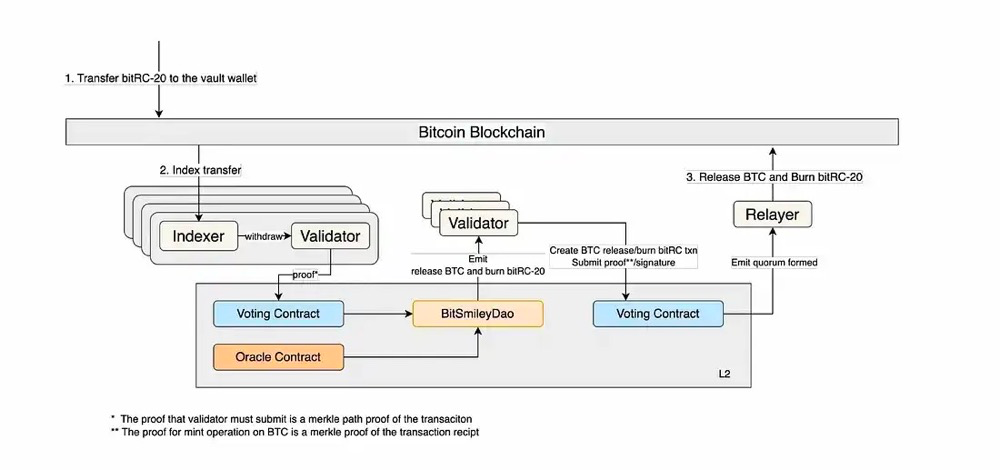
BitSmiley has received investments from OKX Ventures, ABCDE Capital, Forsight Ventures, Waterdrip Capital, Kucoin Ventures, CMS Holdings, ArkStream Capital, among others. In the early stages of the project, BitSmiley issued the Ordinals NFT M-bitDisc-Black, which received good market feedback and is used as a ticket to participate in the testnet.
build_on_bob: BTC EVM sidechain architecture
BOB is a BTC EVM sidechain architecture implemented using the OP Superchain SDK, using wrapped BTC such as wBTC and tBTC on ETH as gas fees, and will introduce BTC security through a new POW merge mining protocol in the future. The BOB testnet has been running for several months and has a certain ecosystem. On May 1st, the mainnet was officially launched. In the first phase, over 40 projects have been deployed on the chain, with over $300 million TVL. The second phase of the deposit activity is currently underway. Accumulated Spice points from the deposit correspond to $BOB tokens.
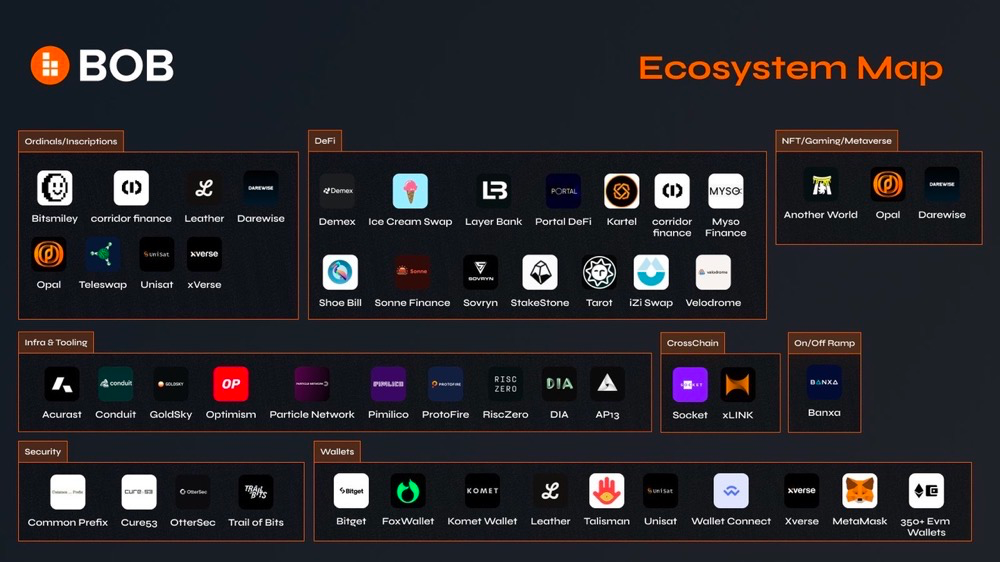
Participation in pre-staking with BOB requires operations on the ETH mainnet, and if using BTC, it needs to be cross-chained to $tBTC, $wBTC, with a reward multiplier of 1.5x. It also accepts DAI, eDLLR, rETH, USDC, USDT, wstETH, STONE, with a staking reward multiplier of 1.3x, and accepts ALEX, ETH, eSOV for staking with a reward multiplier of 1x. BOB has strong resources and has collaborated with the largest publicly traded mining company in the US, $MARA, to launch BTC L2, and has announced a $10 million investment from Coinbase, with great potential.
Botanix Labs: EVM equivalent L2 on Bitcoin
Botanix Labs has built an EVM equivalent L2 on Bitcoin, operated by PoS. Users can stake BTC in a multi-signature address to participate in staking on L2 or bridge BTC to participate in the ecosystem. The unique feature is that these BTC assets are protected by the decentralized multi-signature network Spiderchain.
By staking BTC to become a validator node and participating in PoS and the multi-signature network Spiderchain, Botanix uses the hash value of Bitcoin blocks as the source, randomly selects nodes to participate in PoS block production, and engraves the block header into the BTC block upon final confirmation. All assets on L2 on BTC are protected by the multi-signature network Spiderchain, with nodes randomly forming multi-signature groups to control BTC in multi-signature addresses, making the cost of malicious behavior high, as the staked BTC can be confiscated.
On May 7, 2024, Botanix Labs announced a $11.5 million funding round, with participation from Polychain Capital, Placeholder Capital, Valor Equity Partners, as well as angel investors such as Andrew Kang, Fiskantes, Dan Held, The Crypto Dog, and Domo (founder of BRC20).
Botanix's testnet has been running for six months, allowing users to participate in testing and receive a series of NFT credentials. Botanix Labs has been building L2 on BTC since 2022 and has a certain level of technical strength, making the testnet a good opportunity for participation.
bounce_bit: BTC yield and restaking infrastructure
BounceBit is a BTC-based yield and restaking infrastructure that integrates CeFi and DeFi businesses, using BTC collateral to secure blockchain security. BounceBit is also a BTC EVM L2, where PoS staking on L2 can be done with native token BB or BTC assets. The absorbed BTC assets are held in centralized custody services supported by Mainnet Digital and Ceffu. Deposited BTC assets on BounceBit become bounceBTC, which can be staked to earn validation rewards from other validator networks. BounceBit brings triple income to users: mainnet BTC asset custody income, on-chain staking project income, and restaking rewards.
BounceBit is supported by Binance and will provide 8% of the token to Binance Megadrop BNB stakers.
citrea_xyz: ZK Rollup enhancing Bitcoin block space
Citrea is a ZK Rollup based on Bitcoin (BTC) that enhances block space functionality, developed by the Chainway team, focusing on early implementation of BitVM verification. The Citrea network processes transactions in zkVM and generates zk proofs, which are inscribed into BTC blocks. Through BitVM, optimistic verification is achieved on the BTC mainnet, ensuring Citrea's settlement and data availability are handled by the Bitcoin mainnet.
Citrea implements asset bridging between L2 and the BTC mainnet through the trust-minimized bridge Clementine. When users need to withdraw BTC from L2, assets are transferred to the withdrawal contract on L2 with a BTC address. The bridge operator first transfers their own BTC assets to the user. Every six months, the Clementine bridge undergoes an interruption check, where the operator must extract the deserved BTC based on the original transaction data, SPV withdrawal proof, and Citrea's zk proof. If the operator behaves maliciously, challengers can initiate a challenge, revealing the original transaction data to prevent the operator from extracting BTC from the bridge, ensuring the safety of bridge assets.
Currently, Citrea has completed a $2.7 million seed round of financing, led by Galaxy, with investors including Delphi Ventures, Eric Wall, Anurag Arjun, BatuX, Igor Barinov, and James Parillo.
Mintlayer: PoS-based Bitcoin sidechain
Mintlayer is a PoS-based Bitcoin sidechain that uses verifiable random functions (VRF) to ensure stable block production. Similar to BTC, Mintlayer adopts the UTXO structure, allowing it to directly benefit from various advantages of the BTC network. Token issuance on Mintlayer does not require smart contracts; instead, it is done through UTXO annotations, similar to BTC's colored coins. It also supports atomic swaps using UTXO, enabling asset exchanges with the BTC mainnet through hash time-locked contracts, which is not achievable by BTC L2 with EVM and account structure.
Mintlayer has incubated the on-chain DeFi product Atomiq DeFi, which leverages the features of atomic swaps, allowing direct interaction with the mainnet BTC in Atomiq DeFi. The $ATMQ token of Mintlayer will be issued at the end of the second quarter.
NervosNetwork: Smart contract platform based on PoW and UTXO model
Nervos is a smart contract platform based on proof of work (PoW) and the UTXO model, proposing a comprehensive solution to expand the BTC ecosystem by 2024 and issuing the RGB++ Bitcoin layer asset issuance and expansion protocol. Based on years of accumulation of the UTXO model, its RGB++ and UTXO isomorphic binding scheme directly utilizes the native capabilities of BTC, with high security and a strong connection to the BTC mainnet.
RGB++ issues assets on the BTC mainnet, with a binding relationship to Bitcoin UTXO. Users can choose to "jump" RGB++ assets to the Nervos network. The BTC transaction for jumping will output specific UTXO on the mainnet, triggering related shadow transactions on the Nervos network, with RGB++ asset information written into Nervos UTXO. The unlocking condition is specific BTC UTXO. Users can enjoy smart contract capabilities, lower fees, and higher performance on Nervos, and can also jump assets back to the BTC mainnet through isomorphic binding.
Based on this isomorphic binding approach, Nervos has also released the UTXO Stack application chain architecture, similar to Ethereum's OP Stack, and is developing its own Lightning Network. Nervos has the most comprehensive solution for expanding the BTC ecosystem.
Mezo: BTC L2 based on tBTC
Mezo is a BTC Layer 2 network built on tBTC, using the Cosmos EVM architecture to achieve asset transfer from BTC to Mezo L2 through tBTC's multi-signature cross-chain bridge. Mezo introduces HODL Proof's Pareto economics, similar to BTC staking's ve33. Users can lock BTC on Mezo to participate in consensus, with longer lock-up periods resulting in exponentially increased staking validation weight and rewards.
Mezo's PoS is divided into BTC and native token MEZO parts, both of which can earn veMEZO as rewards, incentivizing different reward pools, with 1/3 of the total rewards going to BTC stakers and 2/3 to MEZO stakers. Mezo has completed a $21 million Series A financing round, led by Pantera Capital, with participation from Multicoin, Hack VC, Draper Associates, and others. Mezo has initiated early deposit activities, allowing deposits and withdrawals of native BTC, wBTC, and tBTC, with the mainnet expected to launch in the second half of 2024.
BVMnetwork: Rollup-aaS platform supporting unlimited scalability
- BVMnetwork is a modular BTC L2 protocol on Bitcoin. It features batch issuance of L2 related to the BTC ecosystem, with each L2 optimized for specific purposes.
- BVMnetwork is positioned as Rollup as a Service (Rollup-aaS). Technically, it adopts a model similar to EVM, using Bitcoin as the data layer to achieve transaction-level consensus. Through the use of TxWriter and TxReader, BVMnetwork embeds BVM transactions into Bitcoin transactions and ensures all BVM nodes maintain a consistent state on the network. TxWriter embeds BVM transactions into Bitcoin transactions, similar to the Ordinals technique. TxReader filters BVM transactions in each new Bitcoin block. BVMnetwork is based on Op-Rollups' multi-layer architecture, including data availability (DA), smart contract platform, Sequencer, Rollup nodes, execution engine, settlement, and bridging. BVMnetwork provides a fully hosted solution, allowing users to deploy a BVM Chain with just a few clicks and choose the most suitable configuration for their application.
- The current market value of $BVM is $143 million, with a total supply of 100 million and a circulation of 23 million. The token TGE took place on March 24, 2024, and is currently in the staking phase. Users can stake BVM tokens to mine SHARD (BVM's governance token), with an annualized yield rate (APR) of 50% as provided on the official website. Users can also participate in mining other newly launched BTC L2 tokens.
BitLayerLabs: BTC L2 project based on BitVM
- BitLayerLabs is the first BTC Layer 2 network based on BitVM, supporting multiple virtual machines and EVM compatibility, using Op-Rollup technology. It announced the completion of a $5 million seed round of financing on March 27, 2024, led by Framework Ventures and ABCDE Capital. Other participating institutions include StarkWare, OKX Ventures, Alliance DAO, and UTXO Management. On May 19, it received strategic financing from OKX, with the amount undisclosed.
- BitLayerLabs is positioned as Op-Rollup, and its asset bridging method plans to use DLC and BitVM, allowing users to withdraw assets on BTC even when issues arise on the mainnet (escape channel). Through BitVM, BitLayerLabs can build a Turing-complete computing layer on the Bitcoin stack, using basic building blocks (such as hash locks, time locks, and large merkle trees) to create a system capable of handling complex computations and contracts. BitLayerLabs supports multiple virtual machines, including EVM, CairoVM, SolVM, and MoveVM.
- However, the current mainnet uses a PoS + multi-signature bridge approach. BitLayer plans to implement a minimal BitVM implementation to replace the current bridging solution in Q2 2025.
- Bitlayer has released mainnet V1 and announced developer incentive programs and early supporter NFT activities. It is currently conducting mining activities in collaboration with Lorenzo, Bitsmiley, Avalon, Bitcow, Pell, Enzo, and Bitparty, with the activity running for two weeks until June 10.
Alpen Labs: Modular ZK-Rollup project
- Alpen Labs is dedicated to developing ZK-Rollup technology, with a focus on modular ZK-Rollup, native ZK verifiers, and optimistic ZK bridges, despite limited disclosed information. The team and financing background are quite strong.
Alpen Labs' ZK verification technology continues the BitVM approach but has designed a dedicated ZK SNARK verifier, SNARKnado, specifically for Bitcoin. Compared to BitVM's verifier design, SNARKnado can reduce the rounds of interactive verification, thereby increasing feasibility. Some of the code has been open-sourced.
On April 10, 2024, Alpen Labs announced the completion of a $10.6 million seed round of financing, which was actually completed in 2023. Investors include Castle Island Ventures, Robot Ventures, Axiom Capital, and others. CEO and founder Simanta Gautam established Alpen Labs in 2022, focusing on BTC and zkSNARKs. Gautam, an MIT graduate, has previously worked as a research intern at MIT, NASA, Amazon, and founded Synapse. Alpen Labs has not yet published its code on GitHub, and the roadmap has not been released.
Pionex: Sidechain system supported by NASDAQ-listed mining company Mara
- Pionex is a multi-sidechain platform incubated by the NASDAQ-listed mining company Marathon Digital Holdings, aiming to provide sidechain solutions.
- Pionex has designed two sidechains: the BTC-compatible COORDINATE and the ETH-compatible ALYS. COORDINATE is a UTXO chain that supports protocol innovations such as Ordinals, while ALYS targets real-world asset (RWA) entities.
- All Pionex sidechains are merged-mined with Bitcoin, and its native asset Anduro BTC is pegged 1:1 to BTC. The Pionex sidechains maximize compliance with Bitcoin's native properties, including block generation using proof of work (PoW).
anetaBTC: Wrapped BTC based on Cardano and Ergo
- anetaBTC is a Wrapped BTC project based on Cardano and Ergo, aiming to achieve BTC liquidity in the DeFi ecosystems of these two chains. By using smart contracts to mint and redeem AnetaBTC, BTC holders can participate in various activities in the Cardano and Ergo DeFi ecosystems, such as lending, trading, and liquidity mining, without giving up their BTC holdings.
- The project's tokens include $cBTC, $NETA, and $cNETA, with $cBTC being the Wrapped BTC token minted on the Cardano and Ergo networks by anchoring BTC. Currently, $cBTC is still being minted, and the TGE of $cNETA has been completed. $cBTC is the project's Wrapped BTC, with 17.6 tokens minted. $NETA and $cNETA are the project's tokens, with a total supply of 2 billion, issued on Ergo and Cardano, respectively. The market value of cNETA is currently $2.53 million, with 70% publicly allocated.
- The anetaBTC project has launched the V1 version of its mainnet, with the V2 testnet expected to be released in the second quarter of 2024, and the V2 mainnet planned for the third quarter of 2024, with the V3 version scheduled for release in 2025.
BiopDAO: Op Rollup project supporting BRC-20 protocol
- BiopDAO is an Op Rollup project focused on supporting the BRC-20 protocol and providing the Biop Virtual Machine (BVM) to support smart contracts. The project aims to create an efficient, secure, and scalable Layer 2 solution. The main token of BiopDAO is $Biop, with a total supply of 21,000,000. Currently, the market value of $Biop is approximately $500,000, with a fully diluted valuation (FDV) of $2.5 million. BiopDAO plans to launch three versions of L2 blockchains: V1, V2, and V3. The V1 version is planned for release in the first quarter of 2024, the V2 version in the second quarter of 2024, and the V3 version in the fourth quarter of 2024. Although BiopDAO's code is open-source, the project's progress is currently slow, with low completion.

Bitsat_Official: ZK-Rollup project integrating AI into BTC L2
- Bitsat is a full-chain interoperability protocol compatible with EVM and Cosmos, aiming to integrate AI into the Bitcoin Layer 2 network (L2).
- The core of Bitsat is HyperLayer, a high-performance, scalable platform for deploying and running distributed AI applications on the Bitcoin network. Technical features include ZK-Connector for efficient data and asset transfer, VM Engine compatible with the Ethereum Virtual Machine (EVM), and an asynchronous high-performance consensus mechanism providing high performance and scalability.
- The project has not yet disclosed related Tokenomics information. The roadmap for Bitsat includes the launch of the testnet in Q2 2024 and the mainnet V1 in Q4 2024.
Bool_Official: Decentralized, secure Bitcoin verification layer
- Bool is a modular data availability (DA) layer using ZK, MPC, and TEE (Trusted Execution Environment) technologies.
- The project aims to provide a decentralized and secure Bitcoin verification layer driven by MPC-based distributed key management. Technical features include the use of Dynamic Hidden Committees (DHC) and Ring VRF protocol to protect member identities, as well as executing all key management processes in a Trusted Execution Environment (TEE). In terms of Tokenomics, $BOOL has a total supply of 1 billion, with an initial allocation of 500 million.
The roadmap includes completing code audit in June 2024, launching the mainnet in July, and opening BTC staking in August and beyond. The code is open-source, with a high level of completion, and is currently awaiting audit.
CashuBTC: Emphasizes privacy-focused BTC project
- Cashu is a free and open-source Chaumian ecash system designed specifically for Bitcoin and deeply integrated with the Lightning Network to ensure privacy. It is well-recognized within the BTC core community. Cashu aims to provide an open electronic cash protocol called Cashu NUT, using blind signatures to protect user privacy, and transactions are peer-to-peer.
BnzkLabs: BTC L2 project based on ZK-Rollup
- BnzkLabs plans to support the Ordinals BRC20 protocol (zkToken), followed by support for BRC721 (zkNFT) and other protocols. Currently, the progress is insufficient, and no code has been seen. In terms of Tokenomics, the total supply of $BNZK tokens is 21 million, with 10% team reserves, 20% ecosystem rewards, 40% public and private sales, and 30% mining rewards. The roadmap includes launching the testnet in April 2024 and the mainnet in September 2024. The current level of completion is average, and no code has been seen.
DrivechainLayerTwoLabs: Bitcoin sidechain technology
- LayerTwo Labs was created by the BTC Drivechain team. Drivechain is a merged-mining BTC sidechain technology designed as a soft fork upgrade for Bitcoin, proposing a new way of interacting with sidechains.
EASTBlue_io: L2 solution focused on large-scale applications
- EASTBlue is a L2 solution focused on large-scale applications, backed by NEAR, using Rollup technology and multi-VM support.
fedimint: Open-source protocol for community custody and trading of Bitcoin
- Fedimint is an open-source protocol for community custody and trading of Bitcoin, emphasizing privacy protection and reducing reliance on large centralized exchanges. Co-founders include Justin Moon and Obi Nwosu, who are co-founders of austinbitdevs.com and former CEO of the UK Bitcoin exchange Coinfloor, respectively. The project has completed a $4.2 million seed round and a $17 million Series A round, totaling $21.21 million in funding. Fedimint has recently released version v0.3.0, making significant progress in automated testing for version compatibility.
GeliosOfficial: Supports Runes standard and EVM-friendly BTC L2
GeliosOfficial: BTC L2 supporting Runes standard and EVM-friendly
Gelios is a BTC L2 that supports the Runes standard and is EVM-friendly, aiming to facilitate communication between applications and seamless cross-chain interactions. Gelios serves as the dApp layer for Bitcoin, allowing users to transfer BTC and WBTC to Gelios, unlocking the potential of BTC DeFi. The project has partnered with Ave.ai, OKX, Bitget, Gate, Unisat, and others. Currently, the 2D card placement game Crimson Heart has been deployed on the Gelios network.
The initial supply of $gOS is 210,000,000, with an initial market value of $40 million and initial liquidity of 100 ETH. $gOS has been launched on Alphanet and can be traded with ETH on Uniswap. The roadmap includes a three-phase airdrop: testnet (completed), Alphanet (ongoing), and mainnet (not started).
HacashCom: Bitcoin solution with multi-layer scaling and state channels
Hacash.com is a project dedicated to solving Bitcoin's scaling issues, achieving one-way transfer of Bitcoin at Layer 1, and deploying state channels for payment operations at Layer 2, further proposing the concept of Layer 3 for ecosystem scaling.
Since its launch in 2019, the Hacash Layer 1 network has utilized a proof-of-work (PoW) consensus mechanism, issuing and settling HACD, BTC, and HAC to address Bitcoin's lack of monetary attributes. Layer 2 is primarily used for large-scale payments, constructing payment settlement channel chains, and serving as the infrastructure for Layer 3. Layer 3 supports multi-chain interaction, ecosystem development, asset issuance, smart contract execution, on-chain data interaction, and cross-chain capabilities. The founding team includes Ken You, Trevor Stoll, and Leo Yang. The project raised $60,000 for listing on the Mexc exchange. It is currently in the testnet phase.
InterlayHQ: Bitcoin-backed assets for cross-chain interoperability
Interlay's flagship product is "interBTC," a fully collateralized one-to-one Bitcoin-backed asset that achieves interoperability between multiple blockchain ecosystems while maintaining Bitcoin's censorship-resistant nature. Technically, Interlay v2 introduces native DeFi functionality, allowing users to easily access Bitcoin-centric DeFi use cases such as swap, Borrow & Lend, Multi-Chain BTC, and Stake BTC by creating markets tailored to Bitcoin holders and establishing deep liquidity in these protocols. Users can mint iBTC by locking BTC at a 1:1 ratio, use iBTC as collateral for DeFi transactions to generate income, and then redeem BTC. Interlay has undergone audits by well-known audit firms informal systems, quarkslab, nccgroup, and security research labs. The founding team includes Alexei Zamyatin and Dominik Harz, both PhDs from Imperial College London. To date, Interlay has completed two rounds of funding, raising a total of $9.5 million. The most recent funding was on December 21, 2021, with a funding amount of $6.5 million, with investment institutions including IOSG Ventures, DFG, HYPERSPHERE, and others.
libreblockchain: Faster, cheaper Bitcoin L2
Libre is a Bitcoin Layer-2 solution that makes Bitcoin and Ordinals faster, cheaper, and easier to program. Libre.org is a new all-in-one platform for Bitcoin Ordinals, offering features such as search, wallet, trading market, and inscriptions. Libre does not require a token, integrates Typescript and other top languages, and allows BTC to be added in seconds without KYC. Libre processes 4000+ transactions per second, with zero transaction fees and on-chain AMM. The mainnet was launched on July 4, 2022, with an airdrop of 10 million LIBRE tokens, of which only 277,000 were claimed. Libre also launched a test version of the BRC 20 Dex and a mobile app for convenient inscription trading.
LightecXYZ: Bitcoin Layer2 solution based on ZKP
LightecXYZ aims to build a Bitcoin Layer2 using zero-knowledge proof (ZKP) technology, with its main projects including opZKP and zkBTC. opZKP completes complex computations off-chain and generates a succinct proof, then introduces new opcodes in the Bitcoin script language to verify the off-chain executed computations on-chain. This solution overcomes Bitcoin's Turing incomplete limitations, making it possible to deploy various applications on Bitcoin. The opZKP technology is complex and has a long development cycle. zkBTC, built on top of opZKP, implements a ZKP-based cross-chain bridge between Bitcoin and Ethereum. This solution allows users to deposit Bitcoin into a specified address to mint ERC-20 token $zkBTC pegged 1:1 to Bitcoin. The entire process involves off-chain generation of ZKP proof, followed by verification of the proof on the Ethereum smart contract to mint the corresponding amount of $zkBTC tokens after confirming the transaction. When redeeming, users need to destroy the corresponding amount of $zkBTC tokens, generate proof off-chain, and redeem Bitcoin after verification. The Lightec team does not hold the private keys of the specified address throughout the process, ensuring security and decentralization.
The Lightec team is actively developing the zkBTC project and is expected to launch the testnet in a few months. At the same time, they are preliminarily building a token economic model to support further development of the opZKP proposal and promote the construction of the Bitcoin Layer2 ecosystem.
Liquid_BTC: Fast, secure, and confidential Layer2 solution for Bitcoin
--------------------------------------------------------------------
The Liquid Network is a Layer2 solution for Bitcoin, providing fast, secure, and confidential settlement and issuance of digital assets, including stablecoins, security tokens, and other financial instruments. The Liquid Network compresses block generation time to within 2 minutes using a special Federated Byzantine Agreement (FBA) protocol. It protects transaction amounts and address information through Confidential Transactions technology and zero-knowledge proofs. The Liquid Network allows users to conduct fast and private transactions using LBTC (Liquid Bitcoin) as a tradable digital asset, with over 3700 LBTC currently in circulation.
The Liquid Network is governed by a distributed alliance of over 65 Bitcoin-centric companies, including Bitbank, BTCBOX, Aquannow, Bitcoin Reserve, Cobo, and OpenNode. Bitfinex Securities launched the first tokenized debt for the New Hilton Hotel, which will be issued on the Liquid Network.
Liquid Network is developed by Blockstream, founded in 2014, with products including Liquid and Blockstream Green. The company raised $21 million in seed funding in 2014, $55 million in Series A funding in 2016, and $210 million in Series B funding in 2021, with a valuation of $3.2 billion.
LumiBitL2: Enhanced scalability, privacy, and decentralization for BTC Layer2
------------------------------------------------------------------------
LumiBit is a BTC Layer2 solution that utilizes ZK-EVM to provide enhanced scalability, privacy, and decentralization. It features a universal circuit design for seamless Ethereum smart contract migration and efficient transaction verification. LumiBit adopts Type2 ZK-EVM, highly compatible with EVM and optimized data structures to improve verification efficiency. It integrates the Halo2 zero-knowledge proof mechanism, enhancing security without requiring trusted setups. It introduces abstract accounts from the Omin wallet, allowing users to transact on the LumiBit chain using local Bitcoin keys. The LumiBit testnet is live.
mercurylayer: Bitcoin L2 focusing on privacy and efficiency
---------------------------------------------------------
Mercury Layer is a Bitcoin Layer2 focusing on enhancing privacy and efficiency through state chains for off-chain transfer and settlement of Bitcoin UTXOs. It utilizes state chains and blind federated signature technology to facilitate instant and fee-free transactions without compromising fund custody and security.
Mirror_L2: Decentralized proof-of-stake Bitcoin Layer2 solution
-------------------------------------------------------------
Pionex is a decentralized proof-of-stake Bitcoin Layer2 solution.
Mirror Staking Protocol, originally known as Mirror L2, is a decentralized proof-of-stake (PoS) BTC Layer2 solution that is compatible with EVM and smart contracts, using BTC as GAS. Mirror Staking Protocol adopts the Overlapping Group Multisignature (MSG) algorithm, collectively managed by hundreds of nodes, balancing BTC staking rate, security, and decentralization. It generates mBTC anchored 1:1 with BTC and compatible with EVM, and has been used in the restaking mechanism.
Mirror has designed a node management scheme. Nodes are elected by the community through four rounds of elections, starting with 100 nodes and gradually increasing to 300, 600, and 1000. Nodes must stake at least 1 BTC to the Mirror channel and act as decentralized network custodians for 12 months. The election champion will receive a bullish option reward of 1 million MIRR (Mirror's governance token) with an execution price of $0.12.
Seed funding was conducted on March 4, 2014, with investors including Conflux, UTXO Management, and IMO Ventures, with the amount undisclosed. In the future, Mirror Staking Protocol plans to establish TVL and an ecosystem through the "Stake Once, Earn Twice" activity with other BTC L2 projects. It announced the completion of the first round of funding and the opening of the testnet in March. Each redemption will earn 10 points, while minting will not earn points.
RolluxL2: Bitcoin Layer2 solution compatible with Ethereum smart contracts
Rollux, developed by Layer1 blockchain Syscoin (SYS), is an Optimistic Rollup equivalent to EVM and plans to transition to a ZK-based Rollup in the future. Rollux supports near-instant transactions and contract deployment, protected by the Bitcoin network. The Syscoin blockchain is a dual-layer blockchain based on PoW consensus, with the core being the Syscoin blockchain, and NEVM providing smart contract functionality.
Syscoin was founded in April 2014 by Layer1 blockchain Syscoin (SYS). In June 2022, Syscoin announced a $20 million ecosystem development fund. Syscoin is listed on Binance, with the current FDV at $170 million.
SovrynBTC: Decentralized trading and lending platform based on Bitcoin
Sovryn is developed on Rootstock (RSK) and is a decentralized trading and lending platform based on Bitcoin, providing a full suite of DeFi services, including stablecoins, AMM, lending pools, and margin trading.
Sovryn's founder, Edan Yago, a graduate of Tel Aviv University, is the founder of CementDAO and Sovryn. John Light, the product manager, was previously the governance lead at Aragon One. The project has undergone 4 rounds of funding: a $2.1 million seed round in 2020 with Greenfield, Collider Ventures, and Monday Capital participating; funding rounds of $12.5 million in January and March 2021; a $9 million funding round in April 2021 with participation from Anthony Pompliano, Cadenza Ventures, Gate Ventures, AscendEX, Blockware, and Consolidated Trading; and a $5.4 million funding round in October 2022 with participation from General Catalyst, Collider Ventures, Bering Waters, Bollinger Investment Group, and Balaji Srinivasan.
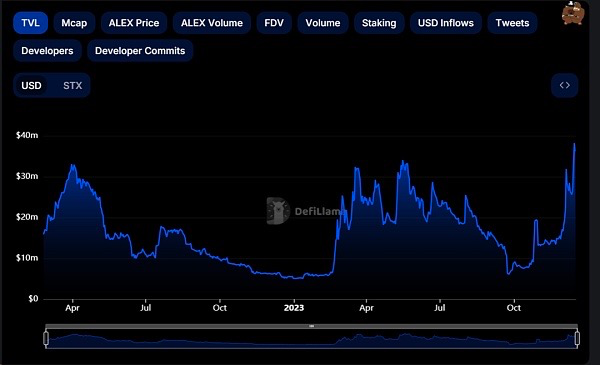
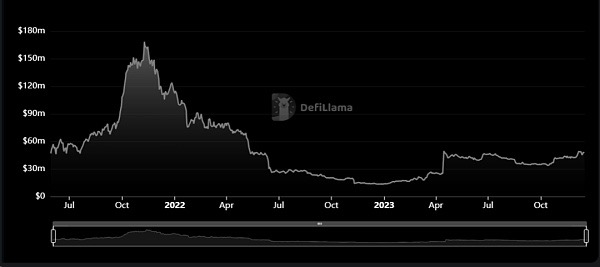
u_protocol: Fully decentralized synthetic BTC across the chain
U Protocol is a native fully decentralized synthetic BTC compatible with EVM, with its main products being uBTC and U Bitcoin Thunder Network. uBTC is a decentralized Bitcoin for Layer 2, supported by Lido's Wrapped Staked Ether and BTC.b. The u_protocol uses BTC pricing, and the redemption mechanism enhances the user experience by charging a one-time redemption fee to prevent frequent redemptions. The system sets a price cap of 1.10 BTC, allowing borrowers to maximize borrowing and sell uBTC for immediate profit when the uBTC:BTC exchange rate exceeds this level.
ZKBaseOfficial: Infrastructure protocol based on ZK technology
ZKBase is based on zero-knowledge proof (ZK) technology, providing scaling solutions for mainstream blockchains such as Ethereum and Bitcoin, offering a range of services including decentralized exchanges, cross-chain bridges, layer2 payments, NFT markets, and layer2 domains. ZKBase will release AMM ZKSwap supporting BRC20 assets to enhance market liquidity and fund efficiency. Compared to other protocols, ZKBase technology focuses on privacy and fast transaction processing while providing a more secure way, equivalent to the security of the BTC network. Chief Strategy Officer Antonio Saaranen previously served as CSO of the Qtum Foundation. Marketing and Public Relations Director Hailan Jia previously served as Senior Public Relations Manager at Huobi Global. In 2020, ZKBase raised $1.7 million in angel funding with a valuation of $25 million, with investors including Bixin Ventures, SNZ Holding, and FBG Capital.
Conclusion
The number of Bitcoin Layer2 projects is rapidly growing, with close to 100 currently in existence, which can generally be divided into four categories.
The first category is EVM sidechains, which is the largest in terms of quantity. Most of these projects deploy EVM chains using a modular rollup approach, using PoS consensus, with a relatively low entrepreneurial threshold, and some projects are attempting to introduce more advanced modular solutions such as ZK.
The second category of projects continues the design concept of BitVM and innovates in the verification method, to some extent introducing BTC security. However, these projects have chosen to first launch a mainnet with EVM + PoS to develop the ecosystem, which is essentially no different from the first category of EVM sidechains. There is a certain narrative expectation, often able to obtain a large amount of funding, which is also a track of concentrated investment by VCs.
The third category of projects focuses on BTC deposit staking, using BTC as the staked asset in PoS, and introducing the concept of BTC re-staking similar to eigenlayer, attempting to attract more BTC savings. The leading project Babylon innovates in the cryptographic aspect of BTC staking, while other projects mostly innovate at the business level, such as introducing BTC staking into CeFi to create more income. We believe that BTC re-staking will be the mainstream of the future ecosystem. Before achieving BitVM, its provision of staking security will solve the BTC narrative dilemma in the above-mentioned BTC EVM sidechains.
The fourth category of projects has conducted more exploration on BTC native, such as further developing the UTXO model and attempting to create new sidechain asset binding schemes based on UTXO, such as Nervos. The exploration of BTC native also includes the continued exploration of joint mining sidechains. A few projects are also attempting to promote BTC upgrades to introduce more script operators to expand the BTC ecosystem, which is currently the most degen line.
The BTC ecosystem is in a rapid development stage, with various innovative projects emerging to address the challenges of scalability, security, and efficiency in the Bitcoin network. From Babylon's cross-chain staking to Nubit's expanded data availability, from Lorenzo's liquidity staking protocol to BitSmiley's comprehensive DeFi protocol, these projects are collectively driving the diversified development of the Bitcoin ecosystem through different technological paths and business models. By continuously paying attention to and participating in these cutting-edge projects, the community and developers will be able to better grasp the future development trends of blockchain technology and jointly build a more efficient, secure, and diverse blockchain ecosystem.
免责声明:本文章仅代表作者个人观点,不代表本平台的立场和观点。本文章仅供信息分享,不构成对任何人的任何投资建议。用户与作者之间的任何争议,与本平台无关。如网页中刊载的文章或图片涉及侵权,请提供相关的权利证明和身份证明发送邮件到support@aicoin.com,本平台相关工作人员将会进行核查。




